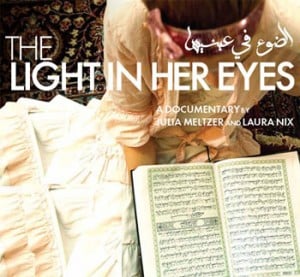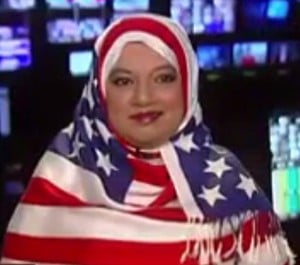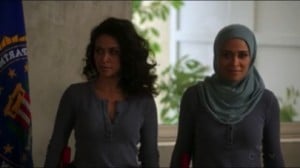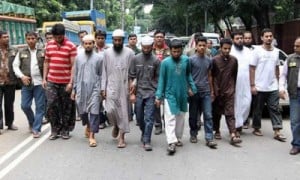We are bombarded with images from Syria every day — flashing across our television screens and updating in our Facebook newsfeeds. They are horrific pictures of the carnage left in the aftermath of massacres. It has been over a year now since the beginning of the Syrian uprising and there seems to be no relief from the continuing assaults on the Syrian people. At a time when we risk becoming desensitized to this ongoing horror, it is important to truly see the people in the images playing out in our living rooms, and to be reminded that they are not so worlds-apart from us.
This reminder comes in the heartfelt form of a documentary film titled, “The Light in Her Eyes.” I previously posted about this film, which follows the story of Houda al-Habash, the founder and teacher of an all girls’ Qur’an school in Damascus, Syria. Now, as news of Syria grows more desperate by the day, filmmakers Julia Meltzer and Laura Nix give us hope by reminding North American audiences of the aspirations and desires of several inspiring Syrian women.
Set in Damascus, Syria in the summer of 2010, the 58 min film opens with a group of young girls reciting Qur’an and demonstrating their knowledge of Islam. Houda al-Habash is seen teaching these young girls how to memorize Qur’an and overseeing the progress of teachers and students at a number of mosque summer programs across Damascus. This work isn’t new for Houda who, at the age of 17, opened one of the first Qur’an schools for girls in Syria.
What is new however is the number of women and girls who have begun studying and praying in the mosque instead of in their homes. The result is an eye-opening transformation of mosques into women-dominant spaces—what I would dub an Islamic feminist revival which does not position itself as such and therefore does not find itself constrained by frameworks and discussions of the sort.

The film cleverly juxtaposes scenes of the girls with clips of male Muslim clerics explaining that women should stay and pray in the home and additionally, that the pursuit of education—even religious—outside the home diminishes a woman’s abilities to preform her household duties. Meanwhile, the audience is captivated by Houda and her daughter Enas, both of whom are educated, yet seen preforming household duties without any “conflict of interest.”
The film touches on a number of topics: marriage, cultural traditions, religious traditions, education, hijab, politics, and gender rights. Audiences can see these topics discussed in the most candid and intimate of gatherings—between girlfriends, over a cup of tea, at a lunch date. Yet all these conversations come back to a common theme: worship. The goal, even of education, is not empowerment nor is it the realization of rights themselves; rather, it is about ibadah (worship) for these women.
The empowerment gained, rights attained, and autonomy claimed seems to be an unanticipated but welcome consequence. I believe this results in making the means purer and the ends freer from the limits we often find ourselves confronting in our pursuit of rights and equality. The movie had me questioning my own notions of Islamic feminism and reminding myself that my position as a Muslim woman makes my pursuit of feminist ideals [equality, rights, autonomy, and empowerment] ultimately a pursuit of God.
The only part of the documentary I found cringe-worthy was Houda’s emphasis on hijab as a symbol status and the lengthy inclusion of footage on the subject. In the “hijab ceremony,” put on for the girls of the mosque school who had come of age, we hear Houda’s opinion of hijab. Houda tells the girls that God made the hijab an obligation, to protect women from inappropriate looks and acts and to protect a woman’s purity for her husband. She says,
“The hijab is an emblem. It signifies that I belong to the school of Islam. A flag symbolizes the state. And this hijab symbolizes Islam. So take care of it and beware not to taint it because then your sin is two-fold. First, you have sinned. Second, you have not been faithful to the emblem.”
They then show the hijab ceremony, where the girls who choose to wear hijab get a white satin fabric ceremoniously draped around their heads in front of the class. Houda continues:
“The hijab is a woman’s right. It is for her, not against her. We mentioned how hijab is like a flag. No one can inflict an insult upon a flag, because it is a symbol and an identity. It shows you’re a Muslim human being.”
Rather than the hijab meaning many different things for the many different women who choose, or don’t choose, to wear it, Houda’s speech would have one think that the hijab is a ritualistic, monolithic rite of passage in Islam. Staying true to the candid nature of this genre of documentary film, I understand the intention behind leaving such footage in, but I couldn’t help but grimace at the amount of footage documenting discussions of hijab, in a way too homogenous to be illustrative of the variegated opinions and views on the subject.
Despite the above-mentioned problematic depiction, “The Light in Her Eyes” prompts discussion of topics we confront on a daily basis. Its beauty lies in its candid depiction of women who should be recognizable to the audience in their endeavors towards education, religion, and happiness, but who perhaps serve as a reminder that as Muslim women our ends should be different, our intentions wholesome, and our realizations of our personal feminisms, simply stepping stones on our quest towards God.
The film concludes by telling audiences that Houda and her family fled Syria a year after the beginning of the uprising. Still, this rare glimpse into the hearts of these inspiring examples of Syrian women gives some hope that this too shall pass and in its place will remain the beautiful people who were at its conception.
*Tune into PBS on July 19th, @10PM to see the North American premiere of “The Light in Her Eyes.” Information and local listings can be found on pbs.org.
Trailer: http://vimeo.com/24227754











